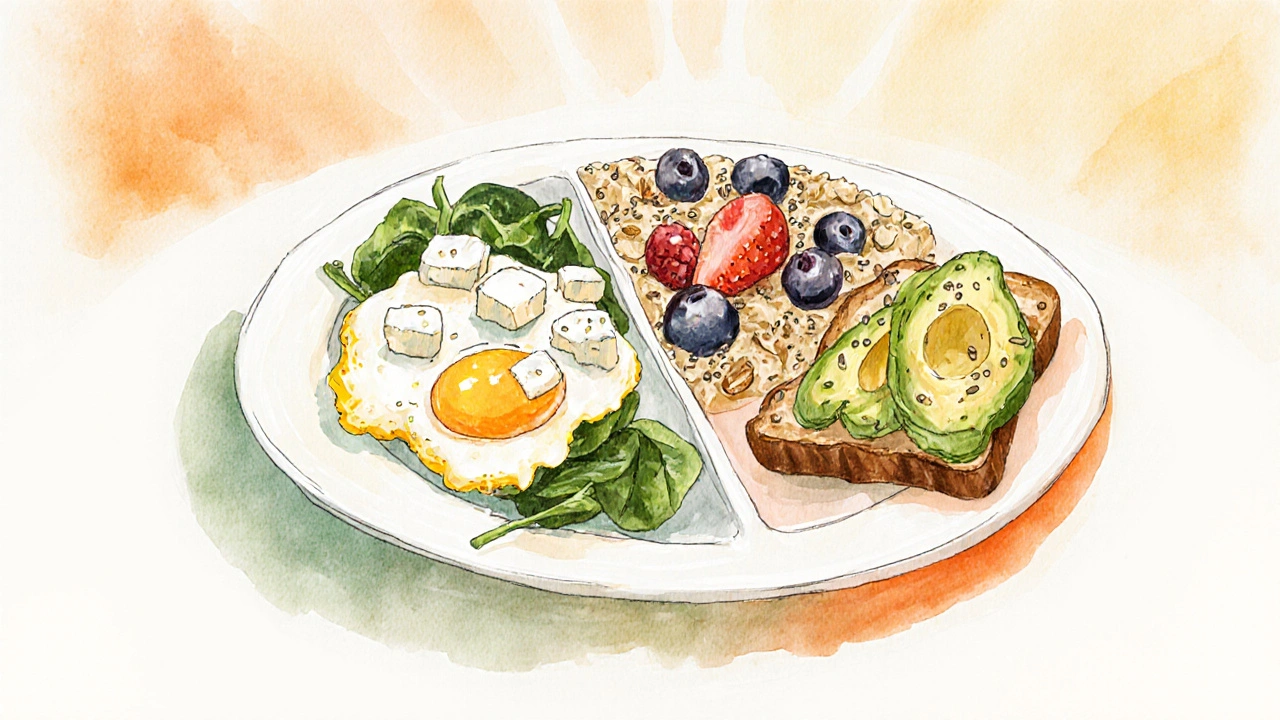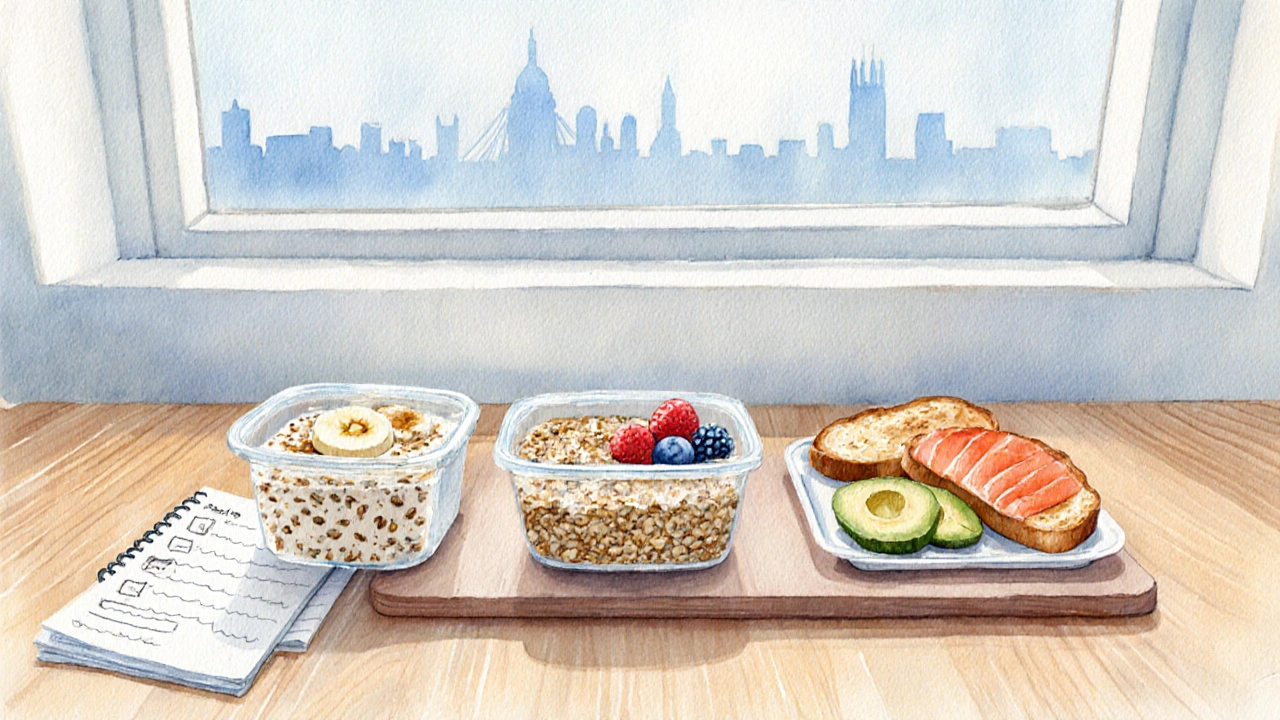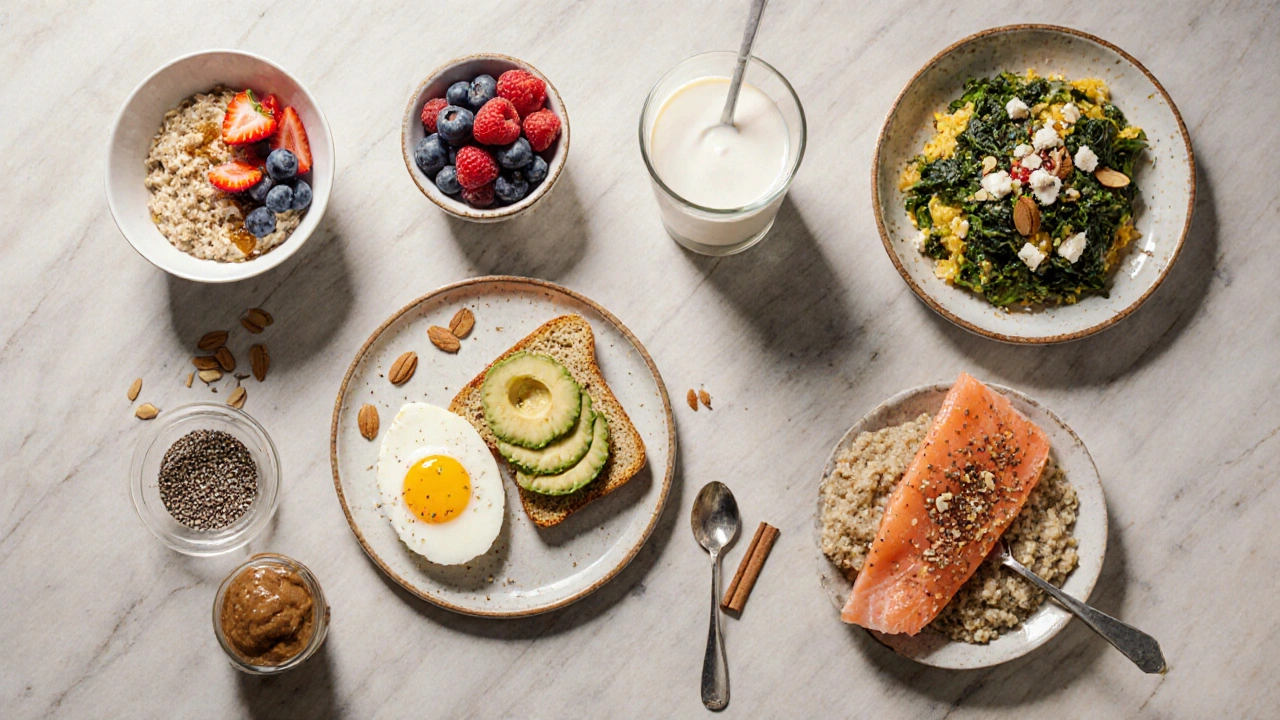Healthy Breakfast Builder
Your Custom Breakfast Plan
Looking for a way to power up your morning without reaching for sugary cereal? Below you’ll find a practical guide to the healthy breakfast foods that keep you full, focused, and ready for whatever the day throws at you.
Key Takeaways
- Combine protein, fiber, and healthy fats for lasting energy.
- Whole grains, dairy or plant‑based alternatives, and fresh fruit top the nutrition chart.
- Simple swaps-like swapping white toast for whole‑grain-add big nutrient gains.
- Prep ahead whenever you can; a few minutes of planning saves minutes of guesswork.
Why Breakfast Matters
Skipping the first meal can tip blood‑sugar levels low, leading to cravings and reduced mental sharpness. Research from the University of Otago in 2024 showed that people who ate a protein‑rich breakfast performed 12% better on memory tasks than those who waited until lunch. The right breakfast also jump‑starts metabolism, helping the body burn calories more efficiently throughout the day.

Top 10 Healthy Breakfast Foods
Below are the foods that consistently rank highest for nutrient density, satiety, and ease of preparation.
1. Oatmeal is a whole‑grain porridge that delivers steady carbs, soluble fiber, and plant protein.
- Key nutrients: beta‑glucan fiber, iron, magnesium.
- Prep tip: Cook with milk or water, stir in a spoonful of nut butter, and top with berries.
2. Greek yogurt provides high‑protein dairy that’s lower in sugar than flavored yogurts.
- Key nutrients: 10‑15g protein per 100g, calcium, probiotics.
- Prep tip: Mix with a drizzle of honey and a handful of sliced almonds for crunch.
3. Eggs are a versatile source of complete protein and essential choline for brain health.
- Key nutrients: 6g protein per egg, vitaminD, lutein.
- Prep tip: Make a quick scramble with spinach and a sprinkle of feta.
4. Berries (blueberries, strawberries, raspberries) pack antioxidants, fiber, and a touch of natural sweetness.
- Key nutrients: VitaminC, anthocyanins, manganese.
- Prep tip: Toss frozen berries into a smoothie or sprinkle over oatmeal.
5. Whole‑grain toast offers complex carbs and more fiber than white bread.
- Key nutrients: B‑vitamins, iron, selenium.
- Prep tip: Mash avocado on top for a dose of healthy fat.
6. Avocado supplies monounsaturated fats that keep you satisfied and support heart health.
- Key nutrients: Potassium, vitaminK, folate.
- Prep tip: Slice on toast or blend into a creamy smoothie.
7. Nut butter (almond, peanut, cashew) adds protein, healthy fat, and a rich flavor punch.
- Key nutrients: VitaminE, magnesium, riboflavin.
- Prep tip: Stir a spoonful into oatmeal or spread on whole‑grain crackers.
8. Chia seeds are tiny powerhouses of fiber, omega‑3 fatty acids, and plant protein.
- Key nutrients: 5g fiber per tablespoon, ALA omega‑3, calcium.
- Prep tip: Soak in almond milk overnight for a ready‑to‑eat pudding.
9. Smoked salmon delivers lean protein and heart‑friendly omega‑3s.
- Key nutrients: VitaminD, selenium, iodine.
- Prep tip: Pair with whole‑grain bagel and a smear of cream cheese for a classic combo.
10. Quinoa porridge offers a gluten‑free grain that’s complete protein and high in magnesium.
- Key nutrients: 8g protein per cup, iron, B‑vitamins.
- Prep tip: Cook with coconut milk, stir in cinnamon, and top with sliced banana.
How to Build a Balanced Breakfast
Think of a breakfast plate as a mini‑nutrient puzzle. Aim for three components:
- Protein - keeps blood‑sugar stable. Choose eggs, Greek yogurt, or plant‑based options like tofu scramble.
- Fiber‑rich carbs - provide steady energy. Whole grains, fruit, and vegetables fit the bill.
- Healthy fats - enhance satiety and support brain function. Avocado, nuts, and seeds are top picks.
When each piece is represented, you’ll feel fuller longer and avoid the mid‑morning slump.
Sample Meal Plans
Mix and match the foods above to suit your taste and schedule. Here are three ready‑to‑go plans.
- Quick 5‑minute: Greek yogurt topped with mixed berries and a tablespoon of chia seeds.
- Prep‑ahead: Overnight oat‑milk mixture with sliced banana, almond butter, and a dash of cinnamon; grab from the fridge in the morning.
- Cook‑once, eat‑twice: Quinoa porridge made in a batch, reheated with fresh fruit, plus a side of smoked salmon and whole‑grain toast.

Nutrition Comparison Table
| Food | Calories | Protein (g) | Fiber (g) | Key Healthy Fat |
|---|---|---|---|---|
| Oatmeal | 68 | 2.4 | 1.7 | None (uses added nuts) |
| Greek yogurt | 59 | 10 | 0 | Low‑fat |
| Eggs | 155 | 13 | 0 | Omega‑3 (if enriched) |
| Berries | 57 | 0.7 | 2.4 | None |
| Avocado | 160 | 2 | 6.7 | Monounsaturated |
| Chia seeds | 486 | 16.5 | 34.4 | Omega‑3 |
| Smoked salmon | 117 | 18 | 0 | Omega‑3 |
| Quinoa (cooked) | 120 | 4.1 | 2.8 | None |
Common Pitfalls & Pro Tips
Even well‑intentioned breakfast plans can slip.
- Relying on sugary drinks. A splash of orange juice looks fresh but adds a quick sugar hit. Swap for water with a squeeze of lemon.
- Skipping protein. A bowl of cereal alone leaves you hungry fast. Add a boiled egg or a scoop of protein powder.
- Choosing low‑fat by default. Fat is not the enemy; it’s essential for nutrient absorption. Include a handful of nuts or a drizzle of olive oil on veggies.
- Forgetting variety. Eating the same thing daily can lead to nutrient gaps. Rotate between oats, quinoa, and whole‑grain breads each week.
Frequently Asked Questions
Can I skip breakfast if I’m trying to lose weight?
Skipping can backfire. A balanced breakfast helps regulate appetite, so you’re less likely to overeat later. Choose a lower‑calorie option like Greek yogurt with berries if you’re counting calories.
What’s the fastest breakfast I can make on a busy morning?
Grab a pre‑portioned container of overnight oats, stir in a spoonful of nut butter, and you’re set in under a minute.
Are smoothies a good breakfast choice?
Yes, if you include protein (Greek yogurt, protein powder), fiber (berries, flax), and healthy fat (avocado, nut butter). A blended mix prevents sugar spikes.
How much protein should I aim for at breakfast?
Around 15‑20g is a solid target for most adults. That amount supports muscle maintenance and keeps hunger at bay until lunch.
Is it okay to eat the same breakfast every day?
It works if the meal covers protein, fiber, and healthy fats. Rotate fruit types, swap oats for quinoa, or change the nut butter to keep micronutrients varied.
By picking from these nutrient‑dense foods and pairing them wisely, you’ll set a positive tone for the rest of your day. Try one new combination each week, and notice how your energy, focus, and mood improve.







